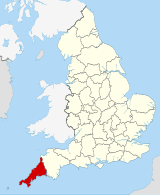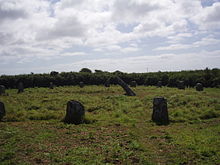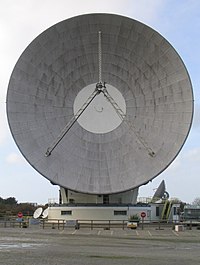Portal:Cornwall
  Cornwall (/ˈkɔːrnwɔːl, -wəl/; Cornish: Kernow; Cornish pronunciation: [ˈkɛrnɔʊ]; or [ˈkɛrnɔ]) is a ceremonial county in South West England. It is recognised by Cornish and Celtic political groups as one of the Celtic nations, and is the homeland of the Cornish people. The county is bordered by the Atlantic Ocean to the north and west, Devon to the east, and the English Channel to the south. The largest settlement is Falmouth, and the county town is the city of Truro. The county is rural, with an area of 1,375 square miles (3,562 km2) and population of 568,210. After Falmouth (23,061), the largest settlements are Penzance, Newquay, St Austell, and Truro. For local government purposes most of Cornwall is a unitary authority area, with the Isles of Scilly having a unique local authority. The Cornish nationalist movement disputes the constitutional status of Cornwall and seeks greater autonomy within the United Kingdom. Cornwall is the westernmost part of the South West Peninsula. Its coastline is characterised by steep cliffs and, to the south, several rias, including those at the mouths of the rivers Fal and Fowey. It includes the southernmost point on Great Britain, Lizard Point, and forms a large part of the Cornwall National Landscape. The national landscape also includes Bodmin Moor, an upland outcrop of the Cornubian batholith granite formation. The county contains many short rivers; the longest is the Tamar, which forms the border with Devon. (Full article...) Selected article The history of Cornwall goes back to the Paleolithic, but in this period Cornwall only had sporadic visits by groups of humans. Continuous occupation started around 10,000 years ago after the end of the last ice age. When recorded history started in the first century BCE, the spoken language was Common Brittonic, and that would develop into Southwestern Brittonic and then the Cornish language. Cornwall was part of the territory of the tribe of the Dumnonii that included modern-day Devon and parts of Somerset. After a period of Roman rule, Cornwall reverted to rule by independent Romano-British leaders and continued to have a close relationship with Brittany and Wales as well as southern Ireland, which neighboured across the Celtic Sea. After the collapse of Dumnonia, the remaining territory of Cornwall came into conflict with neighbouring Wessex. By the middle of the ninth century, Cornwall had fallen under the control of Wessex, but it kept its own culture. In 1337, the title Duke of Cornwall was created by the English monarchy, to be held by the king's eldest son and heir. Cornwall, along with the neighbouring county of Devon, maintained Stannary institutions that granted some local control over its most important product, tin, but by the time of Henry VIII most vestiges of Cornish autonomy had been removed as England became an increasingly centralised state under the Tudor dynasty. Conflicts with the centre took place with the Cornish Rebellion of 1497 and Prayer Book Rebellion of 1549. By the end of the 18th century, Cornwall was administered as an integral part of the Kingdom of Great Britain along with the rest of England and the Cornish language had gone into steep decline. The Industrial Revolution brought huge change to Cornwall, as well as the adoption of Methodism among the general populace, turning the area nonconformist. Decline of mining in Cornwall resulted in mass emigration overseas and the Cornish diaspora, as well as the start of the Celtic Revival and Cornish revival which resulted in the beginnings of Cornish nationalism in the late 20th century. Cornwall's Early Medieval history, in particular the early Welsh and Breton references to a Cornish King named Arthur, have featured in such legendary works as Geoffrey of Monmouth's Historia Regum Britanniae, predating the Arthurian legends of the Matter of Britain (see the list of legendary rulers of Cornwall). (Full article...)Selected biographyJohn Arnold (1736 – 11 August 1799) was an English watchmaker and inventor. John Arnold was the first to design a watch that was both practical and accurate, and also brought the term "chronometer" into use in its modern sense, meaning a precision timekeeper. His technical advances enabled the quantity production of marine chronometers for use on board ships from around 1782. The basic design of these has remained, with a few modifications unchanged until the late twentieth century. His legacy includes, together with Abraham-Louis Breguet, being one of the inventors of the modern mechanical watch. One of his most important inventions, the overcoil balance spring, is still used in most mechanical wristwatches. It was from around 1770 that Arnold developed the portable precision timekeeper, almost from the point where John Harrison ended his work in this field. But, compared to Harrison's complicated and expensive watch, Arnold's basic design was simple whilst consistently accurate and mechanically reliable. Importantly, the relatively simple and conventional design of his movement facilitated its production in quantity at a reasonable price whilst also enabling easier maintenance and adjustment. Three elements were necessary for this achievement:
Did you know?
Selected quoteSelected picture
General imagesThe following are images from various Cornwall-related articles on Wikipedia.
WikiProjects
Related portalsTopicsHistory
Geography
Politics
Economy and demographics
Culture
SubcategoriesRecognised content
Featured articlesMain page featured articlesFeatured listsGood articles
Former good articlesIn the News articlesThings you can do'
Associated WikimediaThe following Wikimedia Foundation sister projects provide more on this subject:
Wikipedia in CornishDiscover Wikipedia using portals
| |||||||||||||||||||||||||||||||||




































































